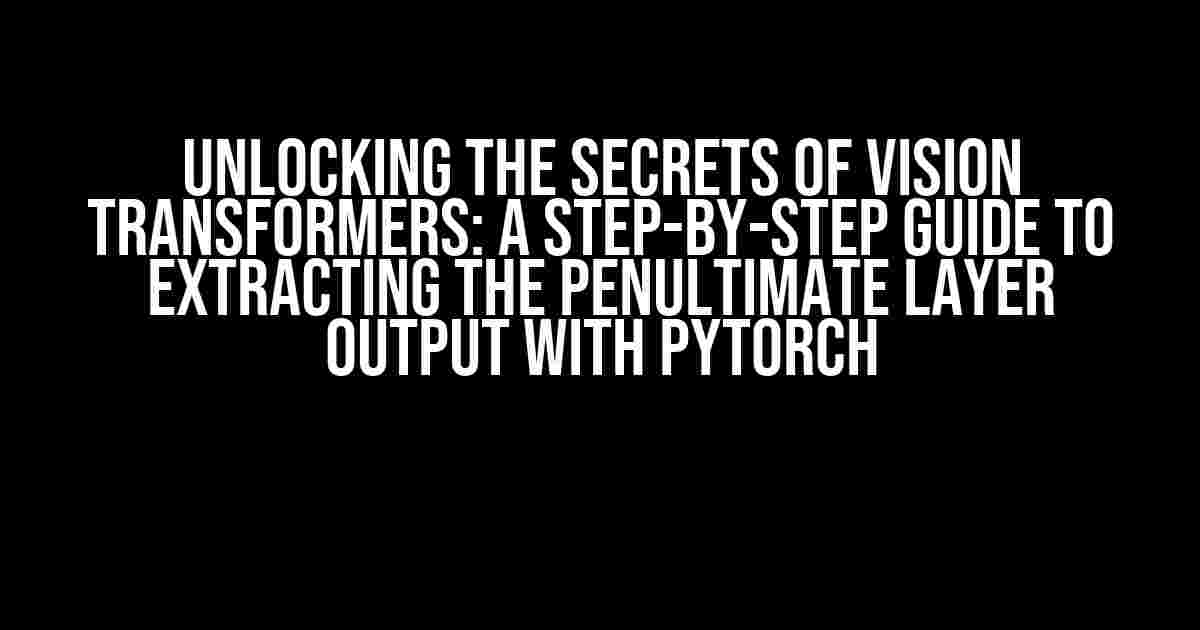Are you tired of scratching your head trying to figure out how to extract the penultimate layer output of a vision transformer with PyTorch? Fear not, dear reader, for we’re about to embark on a thrilling adventure to demystify this complex topic. In this comprehensive guide, we’ll delve into the world of vision transformers, PyTorch, and layer extraction, providing you with clear and direct instructions to unlock the secrets of this powerful technique.
What is a Vision Transformer?
A vision transformer is a type of neural network architecture that has revolutionized the field of computer vision. It’s a transformer-based model that’s specifically designed to handle image data, using self-attention mechanisms to process input sequences in parallel. This approach has led to remarkable breakthroughs in image classification, object detection, and image segmentation tasks.
Why Extract the Penultimate Layer Output?
The penultimate layer output of a vision transformer is a treasure trove of information, providing valuable insights into the model’s internal workings. By extracting this output, you can:
- Analyze feature representations and understand how the model perceives the input data
- Visualize activation maps to identify regions of interest in the input image
- Perform feature extraction for downstream tasks, such as object detection or Segmentation
- Develop more accurate models by fine-tuning the penultimate layer output
Prerequisites
To follow along with this guide, you’ll need:
- Basic knowledge of PyTorch and its ecosystem
- Familiarity with Vision Transformers and their architecture
- A Python environment with PyTorch installed (version 1.9 or later)
- A pre-trained Vision Transformer model (e.g., ViT-B/16 or DeiT-B)
Extracting the Penultimate Layer Output
Now that we’ve set the stage, let’s dive into the main event! Extracting the penultimate layer output of a vision transformer with PyTorch involves the following steps:
- Load the Pre-Trained Model
- Prepare the Input Data
- Forward Pass and Layer Extraction
- Visualize and Analyze the Output
First, load the pre-trained vision transformer model using PyTorch’s `torchvision` module:
import torch
import torchvision
model_name = 'vit_b_16'
model = torchvision.models.vit_b_16(pretrained=True)Next, prepare the input data by loading an image and converting it to a PyTorch tensor:
import torchvision.transforms as transforms
img = torchvision.load_image('path/to/image.jpg')
transform = transforms.Compose([transforms.ToTensor()])
input_tensor = transform(img)Perform a forward pass through the model, and extract the penultimate layer output using PyTorch’s built-in `module` attribute:
output = model(input_tensor.unsqueeze(0))
penultimate_layer_output = output.module.encoder.layers[-2].outputNote that we’re accessing the penultimate layer output using the `layers[-2]` indexing, since the last layer is usually the classification head. Also, we’re using the `unsqueeze(0)` method to add a batch dimension to the input tensor.
Finally, visualize and analyze the penultimate layer output using techniques such as feature map visualization, activation map analysis, or clustering:
import matplotlib.pyplot as plt
plt.imshow(penultimate_layer_output.squeeze(0).detach().numpy())
plt.show()Voilà! You’ve successfully extracted and visualized the penultimate layer output of a vision transformer with PyTorch.
Troubleshooting and Tips
Don’t worry if you encounter any issues during the extraction process. Here are some troubleshooting tips to get you back on track:
- Check the model architecture and ensure that you’re accessing the correct layer output.
- Verify that the input data is properly formatted and normalized.
- Use PyTorch’s built-in debugging tools, such as `torch.autograd.detect_anomaly()`, to identify any issues.
- Consult the PyTorch documentation and Vision Transformer implementation details for specific guidance.
Conclusion
Extracting the penultimate layer output of a vision transformer with PyTorch may seem daunting at first, but with the right guidance, it’s a breeze! By following this step-by-step guide, you’ve unlocked the secrets of this powerful technique, opening up a world of possibilities for feature extraction, visualization, and model fine-tuning.
| Key Takeaways |
|---|
|
Remember, the penultimate layer output is a treasure trove of information, waiting to be unlocked and explored. So, go ahead, experiment with different models, inputs, and visualization techniques to uncover the secrets of vision transformers!
Further Reading
Want to dive deeper into the world of vision transformers and PyTorch? Check out these resources:
- The official PyTorch Vision Transformer implementation: https://github.com/pytorch/vision/tree/main/torchvision/models
- The Vision Transformer paper: https://arxiv.org/abs/2010.11929
- PyTorch documentation: https://pytorch.org/docs/stable/index.html
Happy learning, and see you in the next article!
Frequently Asked Question
Get the insights to tackle the hurdle of extracting the penultimate layer output of a vision transformer with Pytorch.
Q: Why can’t I extract the penultimate layer output of a vision transformer with Pytorch?
A: This is because the vision transformer model’s architecture doesn’t allow for direct access to intermediate layers. You need to modify the model or use a workaround to access the desired layer output.
Q: How do I modify the vision transformer model to access the penultimate layer output?
A: You can modify the model by creating a custom module that inherits from the original model and overrides the forward method to return the desired layer output. Alternatively, you can use Pytorch’s nn.ModuleList to create a new module that consists of the desired layer and the original model.
Q: What is the workaround to access the penultimate layer output without modifying the model?
A: You can use Pytorch’s registration mechanism to register a hook function that will capture the output of the desired layer during the forward pass. This hook function can then store the output in a variable for later use.
Q: Can I use Pytorch’s built-in functionality to access the penultimate layer output?
A: Unfortunately, Pytorch does not provide built-in functionality to directly access intermediate layer outputs. You need to use one of the workarounds mentioned above to achieve this.
Q: Are there any pre-built functions or libraries that can help me extract the penultimate layer output?
A: Yes, there are libraries like Pytorch-Vision-Transformer that provide functions to extract intermediate layer outputs. You can also use third-party libraries like torch-layer-trace that provide similar functionality.

